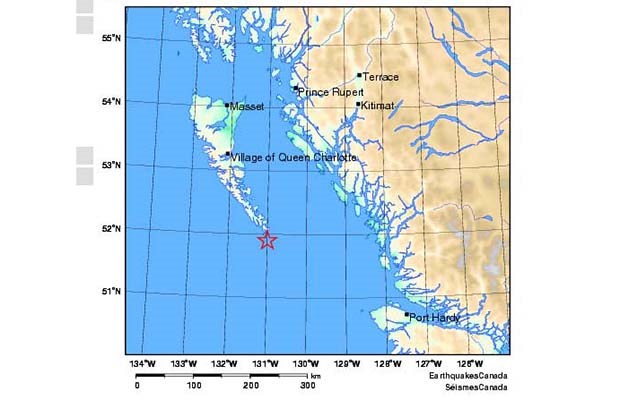A 6.1-magnitude earthquake struck off the southern tip of Haida Gwaii this morning.
The quake, 167 kilometres southeast of the Village of Queen Charlotte, struck just before 7 a.m. and was felt from Haida Gwaii and along the north coast.
A tsunami is not expected to result from the quake, according to the National Tsunami Warning Centre.
A 6.1-magnitude earthquake is a big earthquake and in a populated area would produce frightening shaking and damage, said John Cassidy, seismologist with Natural Resources Canada.
However, today’s earthquake was in a remote 300 kilometres from Prince Rupert and Kitimat, where the earthquake was felt.
“What they felt was fairly minor shaking,” Cassidy said. “There were no damage reports and we wouldn’t expect any because of the remote area.”
Today’s earthquake happened in one of Canada’s most seismically active regions. In 2012, a 7.8-magnitude earthquake occurred just to the north of today’s location. That earthquake has produced aftershocks ever since.
Seismologists have been expecting an earthquake would happen in this specific area, last active in the 1970s.
“Until today, it was one of the quieter segments of that major plate boundary [between the Pacific tectonic plate and the North American tectonic plate],” Cassidy said.
“In many ways, it was expected from the research we’ve been doing,” Cassidy said. “This is a big earthquake but it’s not nearly as big as what we’ve seen in the past and what we expect in the future.”
In the 1970s, there was a 7.4-magnitude earthquake in the same area, and in 1929 there was a 7-magnitude quake.
The U.S. Geological Survey says the quake struck about 10 kilometres under the surface.
“[That’s] quite shallow, and is showing a strike-slip faulting mechanism — for example, a significant tsunami would not have been expected,” said Lucinda Leonard at the University of Victoria’s School of Earth and Ocean Sciences.
Typically a 6.1-magnitude earthquake might happen anywhere around the world about 10 to 20 times a month, Cassidy said.



